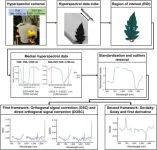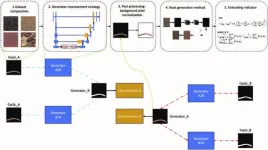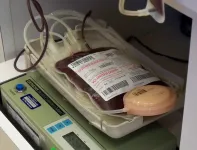(Press-News.org)
Recent advancements in hyperspectral imaging and machine learning have revolutionized the non-destructive monitoring of crop nutritional status, enabling accurate prediction of plant element concentrations. Despite successes, the single-target regression method, which predicts concentrations individually, faces accuracy limitations for certain elements. Traditional methods offer accuracy but at the cost of being destructive and inefficient for large-scale use. Current research highlights the potential of multi-target regression, which considers relationships between multiple elements, as a promising avenue for enhancing prediction accuracy. Yet, the application of multi-target regression in predicting multiple element concentrations in plants remains underexplored and represents a critical area for future investigation.
In January 2024, Plant Phenomics published a research article entitled by “A Multi-Target Regression Method to Predict Element Concentrations in Tomato Leaves Using Hyperspectral Imaging”.
This study aimed to enhance the accuracy of predicting element concentrations in tomato leaves through a multi-target regression (MTSC) method, which integrates sequential chaining of predicted element values into original hyperspectral imaging inputs. Researchers applied this approach on 17 elements and compared it against traditional single-target regression (STR) outcomes, utilizing five different machine learning models. The MTSC method showed a significant improvement in prediction accuracy for 10 elements, with notable increases in the coefficient of determination (R2) for elements like Mn, Cu, Co, Fe, and Mg, demonstrating its superiority over STR.
Their experiments evaluated the variability of the hyperspectral data and showed significant differences within and across tomato plants, which underlines the data's complexity. Initial predictions using STR revealed that certain elements, such as Mg, Mo, and Ca, had relatively higher R2 values, indicating decent model performance. However, for elements with lower prediction accuracies in STR, MTSC offered a promising alternative, significantly improving accuracy for a subset of elements, including Mg, P, S, Mn, Fe, Co, Cu, Sr, Mo, and Cd. This improvement was most pronounced in the Random Forest (RF) model, which showed the highest average increases in R2 and reductions in root mean square error (RMSE).
The effectiveness of the MTSC method was further validated on a test dataset, with predictions for the 10 improved elements outperforming STR predictions. This method's success highlights the importance of considering inter-element relationships and the potential of non-linear machine learning models like RF to exploit these connections for better prediction accuracy. Overall, these findings underscore the MTSC method's capability to significantly enhance element concentration predictions in plant tissues and illustrate method's advantage in incorporating complex inter-elemental relationships, thereby offering a more accurate and holistic approach to predicting plant nutritional status.
###
References
Authors
Andrés Aguilar-Ariza1, Naoyuki Sotta1, Toru Fujiwara1, Wei Guo2, and Takehiro Kamiya1*
Affiliations
1Graduate School of Agricultural and Life Sciences, The University of Tokyo, 1-1-1, Yayoi, Bunkyo-ku, Tokyo 113-8657, Japan.
2Institute for Sustainable Agro-Ecosystem Services, Graduate School of Agricultural and Life Sciences, The University of Tokyo, 1-1-1, Midoricho, Nishitokyo-shi, Tokyo 188-0002, Japan.
About Takehiro Kamiya
He is currently an Associate Professor in the Graduate School of Agricultural and Life Sciences at The University of Tokyo. His research themes are analysis of casparian strip function and development.
END
Woods Hole, Mass. – A healthy coral reef is noisy, full of the croaks, purrs, and grunts of various fishes and the crackling of snapping shrimp. Research suggests that larval animals use this symphony of sounds to help them determine where they should live and grow.
Researchers at the Woods Hole Oceanographic Institution (WHOI) recently demonstrated that replaying healthy reef sounds could potentially be used to encourage coral larvae to recolonize damaged or degraded reefs. A reef that has been ...
The University of Warwick has been awarded £11m to train PhD students in computational modelling.
The new centre will train 50 PhD students to use computational modelling to tackle pressing global sustainability challenges from accessing clean fusion energy, controlling infectious diseases, to designing energy-efficient devices such as new battery electrolytes.
The Centre for Doctoral Training in Modelling of Heterogeneous Systems (HetSys II), led by Professor James Kermode from the School of Engineering, Dr Livia Bartok-Partay from Chemistry and Professor Nicholas Hine from Physics, will train ...
Researchers have published a simple trick that improves the accuracy of techniques that help us understand how external variables – such as temperature – affect gene activity in plants.
“There are really two contributions here,” says Colleen Doherty, corresponding author of a paper on the work and an associate professor of molecular and structural biochemistry at North Carolina State University. “First, we’re raising the visibility of a problem that many of us in the ...
The root system is crucial for plants to absorb water and nutrients, with in situ root research providing insights into root phenotypes and dynamics. While deep-learning-based root segmentation methods have advanced the analysis of root systems, they require extensive manually labeled datasets, which are labor-intensive and time-consuming to produce. Current methods of in situ root observation vary in their effectiveness. Moreover, traditional root image recognition methods face challenges such as subjectivity and ...
About The Study: In this randomized clinical trial of 345 patients with mild-to-moderate COVID-19, viral load rebound and symptom rebound were both common after a standard 5-day course of antiviral treatment with either VV116 or nirmatrelvir-ritonavir. Prolongation of treatment duration might be investigated to reduce COVID-19 rebound.
Authors: Yufang Bi, M.D., and Yiping Xu, M.Sc., of the Shanghai Jiao Tong University School of Medicine in Shanghai, China, are the corresponding authors.
To access the embargoed study: Visit our For ...
About The Study: The findings of this study of 4,515 adolescents suggest that in-person schooling and several coping behaviors (caring for one’s body, exercising, and engaging in healthy behaviors) were associated with significantly higher positive affect and lower perceived stress during the COVID-19 pandemic among adolescents with high adverse childhood experiences (ACEs). Adolescents with high ACEs demonstrated especially greater mental health scores when they reported in-person schooling. Future studies should build on these findings to identify clinical and school-based mental health protective ...
Chlorophyll a fluorescence (ChlF) has been a pivotal tool in understanding plant photochemistry, offering insights into the energy transfer processes within chloroplasts and the efficiency of Photosystem II (PSII). Researchers have relied on quantifying ChlF through specific measures such as F0, Fm, and Fv under various lighting conditions to assess photosynthetic activities. Nonetheless, the technique encounters obstacles owing to the intrinsic uncertainties in gauging the absolute magnitude of ChlF and the fluctuation in baseline levels affected by environmental conditions. This complicates the interpretation of ...
Allergic transfusion reactions (ATRs), a potentially life-threatening side effect of blood transfusions with unclear mechanisms, may be linked to food allergies in pediatric patients as per a recent study by scientists from Japan. They found that ATRs may be triggered by the presence of allergens in the donor’s blood, influenced by their pre-donation diet. These findings could pave the way for safer blood transfusions through the development of preventive measures and countermeasures for ATRs.
Blood transfusions are often life-saving procedures in various medical settings. They are required not only after severe blood loss ...
Melissa A. Kelly, MS, CGC is the recipient of the 2024 ACMG Foundation Carolyn Mills Lovell Genetic Counselor Award. Ms. Kelly received the Lovell award for her platform presentation at the 2024 ACMG Annual Clinical Genetics Meeting, “Integrating genomic medicine into healthcare: Experience disclosing >5,000 clinically relevant results within the Geisinger MyCode Community Health Initiative.”
Ms. Kelly said, “Thank you to the ACMG Foundation. I am humbled and honored to receive the Carolyn Mills Lovell Genetic Counselor Award. Throughout my career, I have seen many ways in which patients and their families interact with and are impacted ...
Rory James Tinker, MD is the recipient of the 2024 Richard King Trainee Award. This award was instituted by the ACMG Foundation for Genetic and Genomic Medicine to encourage American Board of Medical Genetics and Genomics (ABMGG), international equivalents, or genetic counseling trainees in their careers and to foster the publication of the highest quality research in Genetics in Medicine (GIM), an official journal of the ACMG.
Each year the editorial board reviews all articles published in GIM by ...






